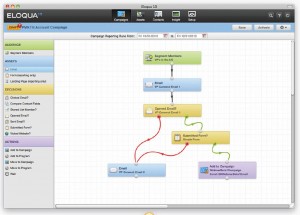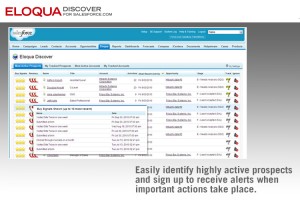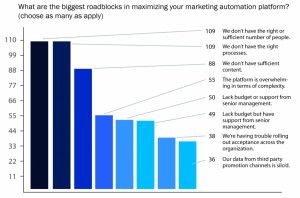Almost 30 people showed up for the first two Marketing Automation Monday meetups in San Francisco and Palo Alto. The topics for these meetings was drip campaigns and lead nurturing. Lots of good ideas and best practices were exchanged, and I wanted to give you a quick summary in this blog post.
Database Segmentation
Segmentation came up several times. You need to tailor your drip campaigns to different audiences. Often, this is based on product, company size, industry or sales channel (direct, partner, affiliate). Some companies were actively capturing more information on prospects (e.g. via progressive profiling), so they could run more targeted campaigns. Another company was pulling revenue information from their billing system into the CRM system.
A recurring theme is that you need to really understand the prospect. Several people had worked with the sales team to better understand the buying process, and one company even started a user experience group to better understand the customers.
Segmentation on Lead Source and Search Keywords
An email marketing vendor found out that people searching for "newsletters" are less sophisticated than those who search for "email software". That's useful info to fine-tune your nurturing programs.
Also, lead source can give valuable clues to the desired length of the nurturing process. One company measured how long it took from initial lead creation until an opportunity was created:
- Organic search: 30 days
- Paid search: 60 days
- Purchased list: 250 days
Interesting enough, once the opportunity was created, it took the same time for the deal to close (6 months), regardless of lead source.
Lead Nurturing Based on Product Usage
Being in the Bay Area, a lot of the attendees worked for software companies. Many of them have trial programs, so potential clients can try the product before they buy. Several people mentioned they were feeding product usage information to their Marketing Automation system to tailor the drip campaigns. Often, this was an automated process, using the Marketing AUtomation system's API.
Some of these same companies are also collecting statistical information on product usage of existing clients, and are running upselling campaigns based on that information.
Pipeline Nurturing
One company found that qualified leads were falling off the sales person's radar when they were not buying within one or two weeks. Therefore, they started a nurturing campaign 3 weeks after the last contact by a sales rep. This resulted in a 7 times increase in close rate, compared to not having the nurturing. Of course, these leads were already qualified, but it shows that nurturing can actually directly help sales people meet their targets.
Email Sent on Behalf of Sales Reps
Talking about sales people: email sent on behalf of a sales rep seems to be used by almost all companies. Everyone agreed that plain formatting worked the best for these "sales" emails. Often, the content of the email is kept short. In one case, the best performing email was actually just one line. Best of all: the unsubscribe rate of these emails is very low. One company even created a fake female persona (including LinkedIn profile), because their prospects were responding way better to a female (IT audience, I guess).
Measuring Replies to Nurturing Emails
However, it's a challenge to measure how many recipients are replying to those emails, as the email goes straight back to the sales rep. One solution was to create an email alias that forwards the email to both the sales rep and another mailbox. That mailbox has to be monitored manually. Another company was saving those replies straight into Salesforce.com.
An additional challenge is to pull prospects out of the campaign after they converted: however, this often depends on a manual action by the sales rep, which is not always happening. One company specifically trained sales people to do this.
Preventing Too Much Email
At one company, product managers for the different product lines could request email campaigns. However, they often specified overlapping segments of the database, causing too much email to be sent. It was a manual process to review the campaigns and prevent annoying the leads.
Another company wanted to automate this. They have multiple automated campaigns that would possibly overlap: they were looking for a way to manage this, having some kind of "traffic cop". This is definitely an area that could use some best practices.
ROI Calculations
Even though the topic of these two meetups was Drip Campaigns, reporting came up as a important topic. Some used customizations of Salesforce.com, others add-on products from their Marketing Automation vendors, one company was using a Business Intelligence tool, and yet others developed a custom solution.
We also had some discussion on campaign attribution, to measure the effect of your lead generation and lead nurturing campaigns. One company decided to do ROI calculations only based on the original lead source, not on campaign influence. They found this was much simpler, and gave approximately the same results.
Next: December 6th – San Francisco & Austin, TX
We had some great discussions at these meetups, so we're already planning the next ones. It looks like we'll have a meeting on December 6th in San Francisco. This will be during Dreamforce in a nearby location. We're also planning a meetup in Austin, TX that same day. Also on the list: New York, Boston, Washington DC and Raleigh-Durham. If you're in any of those areas and you're interested in helping to organize it, please let me know (jep at leadsloth dot com).
Also, if you're not a member yet, please sign up for the Marketing Automation Association LinkedIn Group.

 Lisa Cramer is president and co-founder of LeadLife Solutions, a provider of on-demand lead management software with embedded best practices that generates, scores, and nurtures leads for B2B marketers. In 2009, Lisa was recognized as one of the top five “Most Influential People” in sales lead management. For more information on lead management or best practices, visit
Lisa Cramer is president and co-founder of LeadLife Solutions, a provider of on-demand lead management software with embedded best practices that generates, scores, and nurtures leads for B2B marketers. In 2009, Lisa was recognized as one of the top five “Most Influential People” in sales lead management. For more information on lead management or best practices, visit  This week I attended the Eloqua Experience, Eloqua’s user conference in San Francisco. The big news of this event is the launch of
This week I attended the Eloqua Experience, Eloqua’s user conference in San Francisco. The big news of this event is the launch of 


 At this week’s
At this week’s